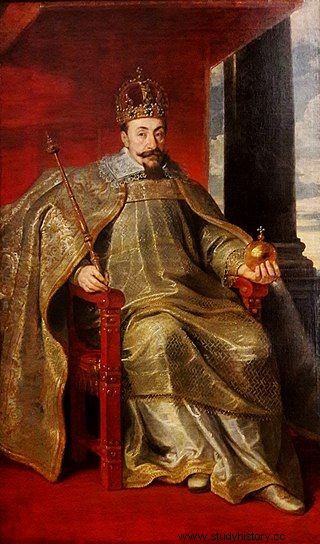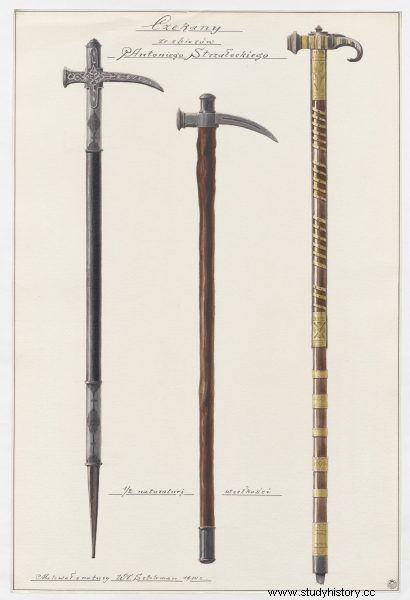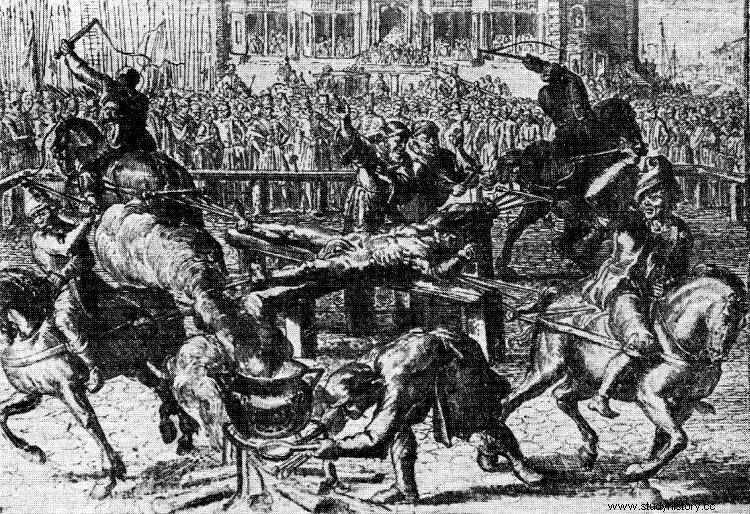This year marks the 400th anniversary of the attempted murder of King Sigismund III Vasa. It was the first attempt at regicide by the nobility in the history of the former Polish-Lithuanian Commonwealth. What was the attack like and why did it happen?
It was Sunday, November 15, 1620, around nine in the morning. The king was heading towards the collegiate church of St. John for mass. He was followed by Jan Wężyk (Przemyśl bishop), Andrzej Próchnicki (Lviv archbishop) and courtiers. The route was the same - from the castle to the collegiate church there was a covered porch over Dziekania Street, which connected the two buildings. At the end of the porch, just outside the door, a man was hiding who was about to murder the king ...
Lord of Bieńkowice and Wodniki
Michał Piekarski, co-heirs of the villages of Bieńkowice and Wodniki, had an accident as a little boy. He became mentally ill because of this incident. He has become hot-tempered or melancholic in turn. While staying with his brother-in-law, the Kraków governor Jan Płazy, he allegedly murdered a cook and injured several other people. Due to illness, he is placed in solitary confinement, and King Zygmunt III Waza (by appealing to Jan Płazy and his brother Erazm Domaszewski, also his brother-in-law) decided to recognize both relatives as Michał's protector.

Zygmunt III Waza was not aware of the existence of his fierce enemy
In Samuel Maskiewicz's Diaries we read:
(...) his brothers-in-law made him mad, and sent a guardianship to the King, taking his property away from him, alone and miserably, and hid them as well.
In this way, Piekarski hated King Zygmunt, who took all his property from him. As soon as he heard about the murder of King Henry IV Bourbon (1610), he knew what he wanted to do. The plan of the royal murder was created in Michał's mind for a decade, during that time he became a highly religious, even devotional man. As part of his intentions, he even made a pilgrimage to Częstochowa to make sure that the plan would succeed. In 1620, King Zygmunt appointed further guardians to the sick Piekarski, there were already five of them in total. This overwhelmed the bit of bitterness.
Fear of Tatars and assassination attempt
Upon the news of the commencement of war preparations by the Ottomans, King Sigismund III Vasa decided to summon a mass mobilization in mid-March 1620. Meanwhile, the Crimean Tatars were preparing for the war and in August they set off towards the Republic of Poland. The main assembly point was to be Cecora. The battle took place at the turn of September and October and was unfortunately lost. The fear that prevailed in Warsaw was unimaginable.
Piekarski hid behind the great door leading to the collegiate church and waited for the king heading towards him. He was holding an ice ax . As soon as the king stopped in front of the door, Michał Piekarski swung his ax at Zygmunt. Due to the fact that the passage was narrow, Piekarski could not use the full impetus of the weapon he had drawn. He hit the king in the back and head (injuring the right ear, right cheek and chin). The king fell, the assassin wanted to use the opportunity and cut Zygmunt once more, but Łukasz Opaliński, the royal court marshal foiled this intention . Using his cane, he knocked the ice ax from Piekarski's hand. Prince Władysław also set out to save my father, but he only harmed the would-be kingslayer.

"Ice axes" (fillers, bagels) from the collection of Antoni Strzałecki
A tumult arose in the narrow passage. In the church, people started screaming and saying that the king had been murdered. There was even a rumor that the Tatars arrived in Warsaw and that they murdered the ruler in cold blood. This time was also a period of considerable tensions between Poland and Sweden (Sigismund III's unsuccessful efforts to keep the Swedish crown), therefore it was suspected that the man trying to kill the king was paid.
Judgment
Piekarski was quickly tried, the sentence was passed 11 days after the attack. Although it was known that the would-be kingslayer would face the death penalty, his act had to be condemned. After all, the nobility and the entire Republic of Poland suffered.
Michał Piekarski's mental illness was not taken into account as a soothing element. After committing such an offense, Piekarski automatically deprived himself of his noble dignity and therefore could have been tortured. The court also divided the criminal's personality into:social (which after the fact was deprived of dignity anyway), legal (depriving him of any rights) and human (lack of humanity).
The judges did everything to destroy the memory of the attack on the king and the criminal himself. Piekarski's descendants were condemned; they could not hold any office (although nothing is known about them). They also wanted to destroy the villages belonging to Piekarski, but this was not done; the land was given to Jan Kaliński, who was the first to help the king get up from the floor after the attack.

The body of Piekarski, torn apart by horses, was burned at the stake, and four cannons launched his ashes to all sides of the world.
Michał Wolski - the Crown Marshal wrote about the verdict:
(...) first, from the place of the prison, from which he will be taken out, by the executioner and his torturers, he will be put on a cart, made for this, with his hands and feet tied, and he will be tied to the cart so that he will remain in the form of a seated person. The executioner and the torturers will sit next to it, with their tools:blazing fire and red-hot coals, they will be driven through the Market Square and the streets of the city. . When he stands in the place of the punishment, from the wagon to the scaffolding, deliberately raised, eight cubits above the ground, he will be led out. There the executioner for him, the iron ax, with which he struck the Bright King of the Lord, will put in his right hand, and with him he will burn a wicked and sacrilegious hand over the flame of fierce fire. Only when it is half-burned well, will it cut off with the sword, the same with the left hand, but it will not burn it. Then, with four horses, the body is broken into four parts, and the disgusting corpse of quarters will be burned to dust on a pile of wood. . At the end, the gunpowder is loaded with gunpowder, a shot through the air will disperse.
Although the judges did their best not to mention Piekarski, the phrase "to mold like Piekarski in torment" has survived to this day. . Before his death, the condemned man spoke incessantly, raved without order. In the memoirs of Albrycht Radziwiłł, we can read that Piekarski quoted the Bible and explained that at the beginning of November an angel appeared to him and ordered the murder of the king.
